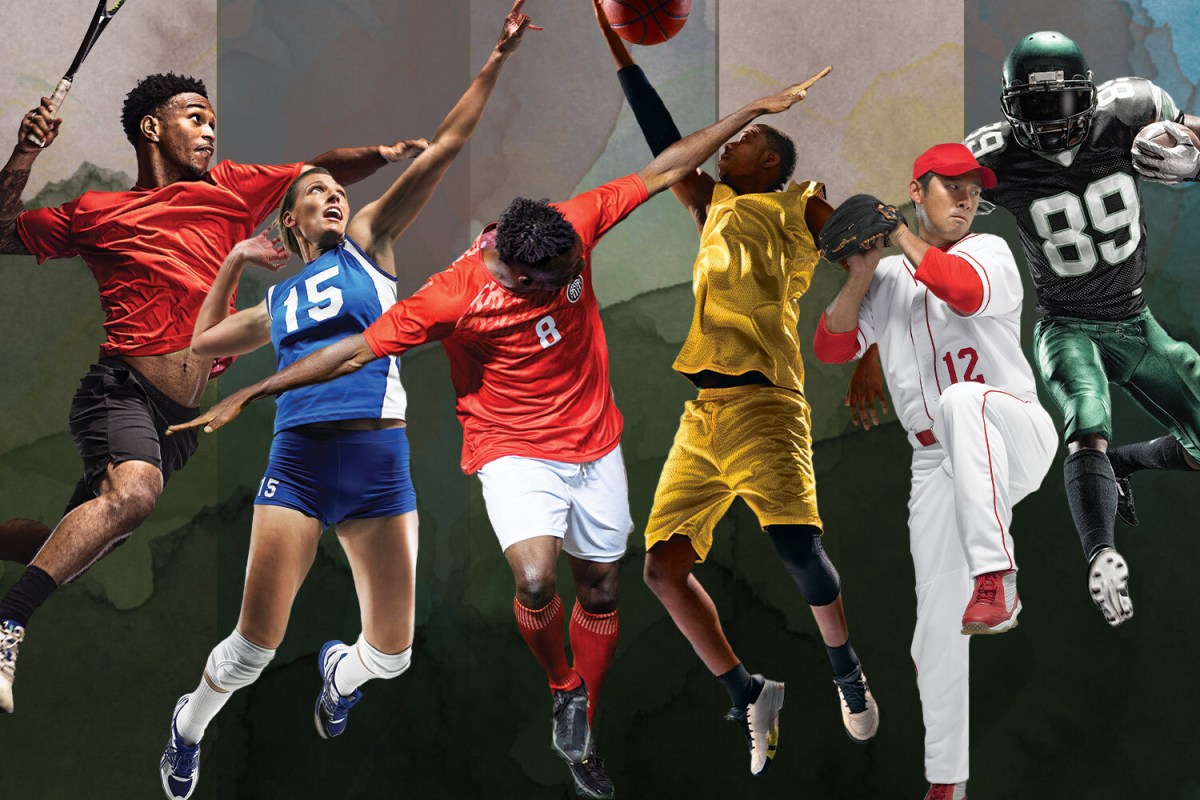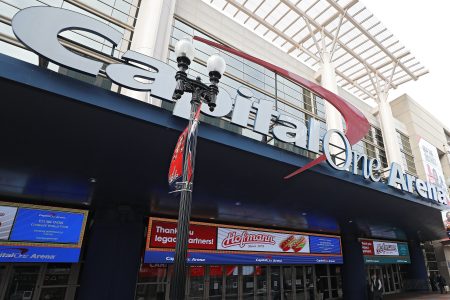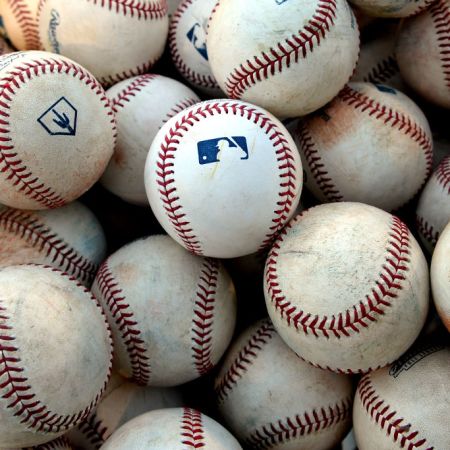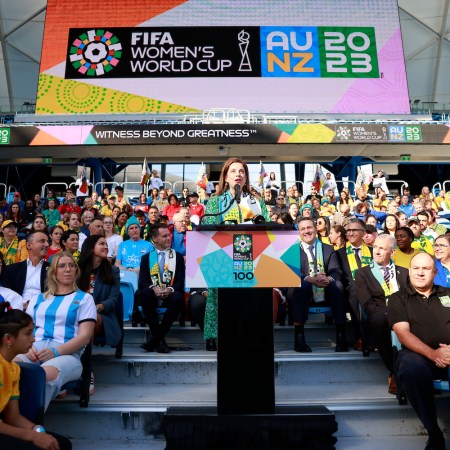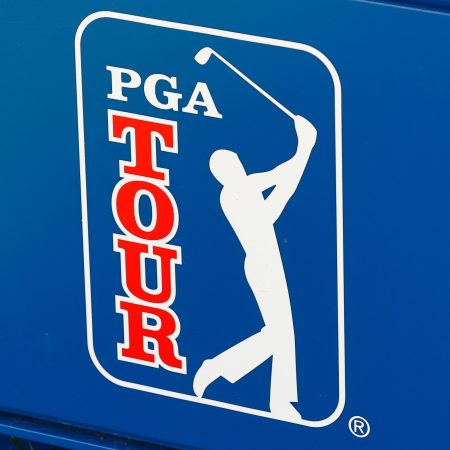If you’ve watched any live television lately, there’s a solid chance you consumed some sports while doing so. I know this because live sports broadcasts accounted for 94 of the top-100 most-watched programs in 2022 — a new record. Eighty-two of them were contests between NFL teams, so you probably popped on NBC, Fox, CBS or Amazon Prime for one at some point. (If you or someone in your home likes watching football players get virtually slimed, then it was Nickelodeon.) Enjoy the college football ranks? Then you almost definitely watched ESPN’s live coverage of the College Football Playoff. Maybe another time you switched on the USA Network for the Olympic Games, or TBS, TNT or truTV for an NCAA Men’s Basketball Tournament match.
You may have watched the State of the Union Address or the Academy Awards, but if in real time your eyes were fixed on pretty much anything outside of those events, as well as all the sports I mentioned, the richest TV advertising dollars were not spent on you. According to industry publication TVNewsCheck, which cited data from iSpot.tv in a February 2023 article, advertisers spent roughly $17.7 billion on national U.S. linear TV sports programming last year. That figure was up nearly 20% from 2021, and doesn’t even include spending on regional sports network advertisements or those on streaming platforms. And this happened while overall TV ad revenue growth actually slumped.
“Live sports continue to be the only show in town,” Jeff Gagne, SVP of strategic investments at Havas Media, a global communications group, told TVNewsCheck. He added that “advertiser spending on live sports will continue to be the long-term trend going forward,” and said TV broadcasters without sports content are “steadily losing viewers.”
It’s no surprise, then, that a recent Bloomberg report says this year TV companies will pay the top-five pro team sports leagues in the U.S. $15.4 billion for broadcast rights, roughly triple the cost they were only a decade or so ago. Why? Because besides sports, there’s generally not a whole lot on live TV that pretty much needs to be consumed in real time. Everything else can be watched on-demand, which people love.
This TV revenue boom in sports — which also includes pre-produced content, like all those Netflix documentary series, as just one example — means that professional teams aren’t as reliant on ticket sales to generate revenue like they once were. It also means that if you’re a sports fan there’s never been a better time to be alive. Options fucking abound.
The 2004 comedy film Dodgeball famously poked fun at the growing number of ESPN channels by placing broadcasts of a fictional professional dodgeball league on “The Ocho,” the sports network’s fictional eighth station. The idea that ESPN would harbor eight different channels felt ludicrous at the time, but nearly 20 years on, the Disney-owned property actually programs eight domestic, in-real-life cable stations, not to mention the streaming platform ESPN+. ESPN2 is sometimes cheekily rebranded as “The Ocho,” the home of “seldom-seen sports from around the world,” like air hockey and something called “death diving,” which, to channel Dodgeball’s Pepper Brooks, sounds deadly. But all the other ESPN outlets need content, too, and the sports that show up on ESPN+ alone are, at times, no less obscure or wild than the dodgeball we saw in that Hollywood movie. Aside from many recognizable mainstays like MMA, ESPN+ also recently broadcasted little league softball, a collegiate summer wooden-bat baseball league called the Northwoods League, second- and third-tier pro soccer leagues, and SlamBall, which is high-contact basketball played on trampolines that make for high-flying dunks. Even a relatively more mainstream sport like lacrosse has Thanksgiving-dinner helpings of action on ESPN+, emanating from multiple organizations, including the Premier Lacrosse League, Athletes Unlimited Lacrosse, All American Lacrosse, and Adrenaline Boys and Adrenaline Girls Lacrosse games featuring high school players.
That’s just a small sample of the ESPN+ programming slate, and if I dared venture deeper into the sports offerings of other broadcasters — of which there are many — this article would easily become an endless list of legacy leagues, their second-rate but thriving imitators, and other sports that range from interestingly innovative to quirky and just dumb (like competitive shin kicking…yes, really). It seems as though every few weeks a new professional sports league is launched, too, with some network somewhere ready to show it on TV. (Whether or not the sport actually draws significant numbers of people to events is growing increasingly irrelevant. Just look at attendance in both of the pro football spring leagues, the USFL and XFL. Yet, they’re still on TV and will play on next year.) There are also new competitions showing up within long-established, high-profile organizations, such as the NBA and MLS, giving content publishers more stuff with which to attract eyeballs and, thus, advertisers.
“The NFL is of course in the stratosphere [in terms of TV viewership]; basketball and baseball are still solid, but everything else is coming back to almost this base level, and I think that creates opportunities for some of these smaller leagues,” says Mike Lewis, a professor of marketing and Faculty Director at Emory University’s Analytics Center, where much of his work focuses on sports business. He says investors of sports today can easily think to themselves that if they can get just a half-million viewers to watch their league, that would justify a TV deal that could go a long way in keeping it afloat. “And so suddenly, women’s softball is almost a major sport,” he says. “You can find professional CrossFit on TV at times — people doing pull-ups.”
But can we get to a point where there’s too much sports? It is possible, and we may soon find out.
“It’s just really an arms race,” says Daniel Kelly, clinical professor and academic director at New York University’s Preston Robert Tisch Institute for Global Sport, referring to today’s sports-investment landscape. “If you don’t invest in it and you miss the turn, the last thing someone wants to be is the last one to the party.” That’s the person who misses out on a beefy return, Kelly says.
When he’s not likening the tidal wave of sports capital investments to geopolitical war-game posturing, he recalls the dot-com bubble of the 1990s, which of course burst in 2000, when the market became too saturated with technology companies built on ideas that ultimately couldn’t compete. Sure, they were richly funded for a while, partly because everyone felt they needed to be at that metaphorical party. But when profits didn’t arrive for many of them, the money people grabbed their coats and left.
Kelly says a similar bursting of the ballooning sports bubble should be a concern for investors, but for now, in his mind, funding sports-based enterprises remains worth the risk.
“Even if the investment doesn’t work, you still have content and sports property aspects to be sold,” he observes. “If you come in with realistic expectations of the timetable, that’s how you’re able to maximize your profitability.”
NFL Owners Officially Approve League’s Controversial Playoff Expansion
Starting with this postseason, the playoff field will expand to 14 teamsThe Role of Generation Z in Sports Profitability
Kelly observes that effectively playing the long game in this arena will mean appealing to Generation Z, the youngest consumer demographic with any real spending power right now. Drawing their attention, however, is challenging, given their unique status as the first generation of “digital natives.”
“Their consumption pattern is totally different than anything we’ve seen before, and it’s constantly changing,” says Kelly. “They seem to be the biggest group that is starting to spend more, and their engagement is very fickle. So once that is figured out, then we’ll be able to see exactly how much of a lifespan these new league investments might have.”
Another problem is a large percentage of Gen Zers do not identify as “avid sports fans.” That rate clocks in at 77%, according to one study from Emory University’s Goizueta Business School, which was led by Mike Lewis, and it’s a significantly higher figure than the accompanying rates for older generations. There’s some additional required context here, though. Young people, who for example generally favor highlight reels to full-game viewing across, say, three hours of time, might have a different definition of what it means to be an “avid fan” compared to older generations. So, it could be all relative.
But when Lewis sees this data and couples it with the rising cost of tickets and other items that signal sports participation — as leagues, content publishers and everyone else in the sports world strives to boost profits — it stokes at least one significant fear in him: “I would have thought this would have happened [already], where just the cost of entry is so expensive to get into sports, to get into these venues, that they hollow out,” he says. Lewis wonders if the big pro sports leagues are merely “harvesting the brand equity” that’s been built over 100-plus years in MLB and 50-plus years in the NFL, for example. “Are they hollowing out and suddenly things are going to fall off a cliff, and you’re not going to have these kinds of sports that are sort of the backbone of society because you price the kids out of the venue?”
Lewis’s study says young people do like esports more than any other age group. So perhaps that niche category is filled with the brightest of opportunities. At least one relatively new professional sports league (whose initial investors arrived fairly early to that aforementioned metaphorical party) tickles that fancy.
Founded in 2015, the Drone Racing League (DRL) bills itself as “the world’s premier, professional drone racing property.” Its recent championship was at LoanDepot Park, home of MLB’s Miami Marlins. Thousands packed into the darkened stadium to watch neon-lit drones piloted by people, who for the most part look like they’re barely past peak pimple years, speed through a course with neon-lit markers.
“We have the best drone pilots in the world racing at locations all around the world,” says Ari Mark, a Senior Vice President and Head of Partnership Development at the DRL. “We have partnerships with blue chip brands like Google Cloud and T Mobile, and the United States Air Force.”
Not bad for a league whose concept was spawned in a Long Island parking lot where the DRL’s founder, Nicholas Horbaczewski, saw a few amateurs racing drones about a decade ago. Mark says 80% of the DRL’s audience is aged 35 and younger, what he calls “a next-gen audience” that tends to be “more tech-savvy and more digitally native.” They’re also “cord-cutters” and “cord-nevers,” as Mark describes them, referring to their rejection of traditional linear TV. The DRL had struck a TV deal with ESPN in time for its first competitions, and its races now air on NBC in the U.S. and, according to Mark, 170 markets abroad. But the futuristic league also pulls revenue from social media livestreams and on-demand plays, meeting consumers where they are in the vast digital landscape.
“It’s a visually arresting sport,” says Mark, who discloses that DRL competitions get millions of viewers across all platforms. When someone catches a glimpse of drone racing, while channel surfing or scrolling through social media feeds, “you say, ‘Wow, I’ve never seen anything like this,’” says Mark. “It looks like a video game brought to life — the speed, the colors, the action, the technology. That is our advantage.”
That kind of draw and prospects for sustainability (manifesting in the average age of the DRL’s fans, but also the DRL’s disposition as a tech-first company with diverse holdings like trademarked drones DRL pilots fly and its simulation video game that’s for sale, not to mention its organic existence in the metaverse) help explain why the DRL has successfully closed more than $80 million in funding from investors.
Another global sport that’s a combination of table tennis and soccer (which means it also looks like it’s part karate at times) called teqball is celebrating its own continued growth thanks to its appeal to young people and eye-catching action that translates well on social media. Viktor Huszár, chairman and co-founder of the sport’s governing body, the International Teqball Federation (FITEQ), founded in 2017, says teqball is the world’s fastest-growing sport, supporting that claim with the fact that in just the past six years 153 different national teqball federations have been built. He also says that when teqball was officially recognized as a sport by the Olympic Committee of Asia in 2018, it was the fastest sport to ever achieve such a distinction. A year later, the Olympic Committee of Africa bestowed the same honor on teqball, as did the Global Association of International Sports Federations in 2020.
On the strength of all this, teqball not only extended its U.S. air rights agreement with ESPN in May, but had them expanded as well. This year, 15 live events, along with eight recap shows, will air across ESPN2, ESPNU and ESPN3. However, the $850,000 teqball receives this year from ESPN only represents a fraction of the revenue that the sport pulls in from overall viewership.
Despite not yet being a part of the global Olympic Games (though that seems like it’ll happen at some point fairly soon), Huszár says views of teqball clips on social media far eclipse those of other legacy Olympic sports. “Sixty or 70 million views on archery? Forget that,” he says. “But with a teqball video…the total viewership is crazy.” One noted ranking of social media followings for all the world’s sports federations placed teqball in 10th place this year, which tracks when one considers that the sport’s most dedicated age group, according to Huszár, is between 14 and 25 years old. Platforms like YouTube and TikTok have made monetizing social media viewership pretty simple, with various partnership programs where creators are compensated based on ad consumption. Huszár says they already help fund teqball growth, but adds that FITEQ is also working on ways to make its sport’s social media content creation even “more strategic.” He also says there’s “huge potential” in “data rights” and gambling partnerships that FITEQ hasn’t even launched yet.
It’s possible, then, that the biggest pro sports leagues of the future will look at linear TV air rights deals the way contemporary ones look at ticket sales: as a significant but not primary source of revenue.
“I believe teqball is [in] the digital new era,” Huszár says. “You look at Major League Soccer, they don’t have a linear [TV] deal. They work with Apple TV, so there are already new enterprise[s] and strategic thinking about that.”
Are New Competitions Actually a Good Idea?
If there’s another sport besides esports that young people in the U.S. appreciate, it’s soccer. In that Goizueta School study by Mike Lewis, Gen Z had the lowest generational fandom rankings across the four top North American team sports, but esports as well as soccer deviated from that trend. According to a recent Washington Post poll, more adults in the 18-to-29 age demo say that soccer is their favorite sport to watch compared to the number who say they prefer baseball, “America’s Pastime.” Correlatively, MLS revenue continues to grow year over year, through traditional means (boosted ticket sales) as well as its streaming (not linear) TV deal with Apple (reportedly worth at least $2.5 billion). Still, MLS’s standing in the U.S. pro sports landscape, in terms of revenue, is a distant fifth.
“The MLS is very well established,” says Steven Goff, soccer reporter for the Washington Post. “They’re always looking to grow, of course.”
Arguably the league’s most audacious growth initiative to date that doesn’t involve international player acquisitions seems to already be paying off. The Leagues Cup, a joint tournament featuring MLS and Liga MX — the top-flight pro soccer league in Mexico — that kicked off last month has spawned sponsor partnerships with Adidas, Coors Light and the financial services group Netspend. (The tournament’s games are also airing on Apple TV.)
Goff believes one reason MLS pursued a tournament with Liga MX is because teams from the Mexican league have built large fan bases in the U.S. In fact, Liga MX viewership in the U.S. has greatly outpaced that of MLS recently.
“So how do you break into that market? That was MLS’s look at it,” says Goff. “And for Liga MX, it’s beneficial because they know there’s a huge market here in the U.S., and they know it could be bigger in terms of attracting fans to their product. So hence, we have the Leagues Cup.”
Goff predicts “it’ll take a few years to catch on,” but appreciates that MLS (and Liga MX) are “trying to do something different” to help grow their brands and soccer in the U.S. as a whole. In watching games in the ongoing Leagues Cup myself, I’ve seen a strong Liga MX fan contingent in the stands at host stadiums, but attendance has been, at best, a mixed bag to this point.
At least one influential MLS fan is not in love with the Leagues Cup. “If you’re watching an MLS cash grab over the World Cup, I can’t help you,” tweeted Jonathan Smith, co-host of the Columbus, Ohio, sports talk radio show “Common Man and T-Bone” (Smith is “T-Bone”), on July 21. That was the night Lionel Messi made his debut with the MLS team Inter Miami CF during a Leagues Cup match. The tail end of that Messi game overlapped with the U.S. Women’s National Team’s first match of this year’s Women’s World Cup.
“The Leagues Cup is one of those things that I view as being very confusing and very gatekeeper-ish, something that bars people from getting into MLS a little bit because it’s yet another thing you have to explain,” says Smith, a sizable supporter of the Columbus Crew MLS club. “It’s a barrier to entry.”
The fact that the Leagues Cup, plus Messi’s debut, took attention away from the USWNT, which Smith points out is “the most successful product we as American soccer fans have,” was in his mind a net negative.
“It was a little bit of frustration that one of the best things we have going in American soccer was getting overshadowed by an aging legend parachuting in to get a huge payday in a tournament that I barely understand,” says Smith. “There’s always some new thing that’s going to make [MLS] better,” he adds with sarcasm, “and if it feels like MLS doesn’t want to participate as much as they should in just really being excited about their league…They just try to do tricks and illusions and sleight of hand.” (Citing busy travel schedules during the Leagues Cup, an MLS communications team staffer could not connect me with a league representative for comment.)
Inspired by soccer — whose history of in-season tournaments hardly starts with the Leagues Cup; abroad, it goes back at least a century and a half — the NBA is launching an in-season tournament of its own this year. Running from November 3 through December 9, the for-now not-cleverly called NBA In-Season Tournament will start with a group stage and then knockout rounds. The new NBA Cup trophy will be lifted in Las Vegas and, all the while, NBA teams will continue on with other regular-season games.
After Saudi Arabia Buys Into PGA, Qatar Takes Stake in NBA, NHL, WNBA
The Qatar Investment Authority bought into the Washington Wizards, Capitals and Mystics“Tradition sometimes impedes progress, making us hesitant to improve and innovate,” wrote Evan Wasch, executive vice president of Basketball Strategy and Analytics at the NBA, in a Sportico op-ed. “But in reality, innovation is the only way new traditions can be created.”
Daniel Kelly, the NYU professor, says the top pro sports leagues in the U.S., including the NBA, have “hit the top of the marketplace” for media deals, and are out to “find new dollars.” The In-Season Tournament is a bold move on the NBA’s part to find those new dollars, but one that comes with a glaring question about player participation. For years the league has had issues with motivating its athletes to suit up for all their team’s games. The phrase “load management” has become a punchline.
We don’t need to look any further than the NBA’s inspiration for the In-Season Tournament for proof that gimmicks like this one — or that of the Leagues Cup, as well as the World Baseball Classic, which has a history of challenges attracting MLB’s best players (though that’s beginning to subside) — might not be embraced by the players being asked to participate. For years, Pep Guardiola, who currently runs the Manchester City FC roster and is widely regarded as one of the finest international football managers, has voiced displeasure with UEFA and FIFA for organizing an excessive number of competitions. He believes they’ve taken a toll on the players, who, if they’re healthy enough to be on the pitch at all, can’t perform to the best of their abilities after being so taxed. Even in the wake of his team’s historic run this past season that yielded three major trophies — England’s Premier League and FA Cup, as well as Europe’s Champions League — Guardiola couldn’t help but bring up the exhausting schedule. “Our players have international games now,” he said shortly after City’s Champions League victory in early June, a game in which his top midfielder, Kevin De Bruyne, who’s also a Belgium international player, completely tore an already ailing hamstring. “UEFA and FIFA, think about it. The Premier League finished two or three weeks ago, now people have to come back. It’s too much.”
Extending the NBA regular season schedule for the In-Season Tournament, then, seems on the surface as though it could exacerbate the league’s load management problem, but the NBA may have already addressed this concern. The schedule has technically only been expanded one game, for the two teams that reach the In-Season Tournament Final. All the other contests count toward the league’s regular season standings. So, if anything, as the league mentioned in a blog post, the In-Season Tournament “provid[es] players and teams with another competition to win.” In other words, the top ends of NBA team rosters will be more motivated to play hard at a time where, normally, sports fans are focused on the heating-up NFL season and recovering from the World Series. The NBA believes better play at that point in the season is a way to better engage fans in a new way, while also generating greater interest — and, of course, new media rights sales — in the early stages of the regular-season schedule.
Even if NBA players suit up for the In-Season Tournament games, however, they might still end up sitting out a number of games between Christmas and the All-Star break, as they rest up for the postseason marathon — games that feel as though they “count” more. MLS teams have rested players during another in-season tournament, for the Lamar Hunt U.S. Open Cup, a competition with a history of such shenanigans. The Leagues Cup, however, is being played with MLS and Liga MX on hiatus, almost surely with player participation and preservation in mind. Still, that approach comes with a risk, too, as attention from the MLS season drifts away for a month. The Leagues Cup also means more games for MLS players over the course of a calendar year, which, regardless of the primary league’s pause on play, is now going to be extra grueling.
“The leagues want to push for more, and the players are pushing back by playing less,” says Kelly. “I think that’s going to be the new dichotomy between the athletes and the owners of the leagues, because the leagues want to increase revenue by increasing the number of games, and they’ll do this by having the in-season tournaments, and the players are pushing back by not playing.”
He says this approach “hurts the product” overall, but it does give more players an opportunity to break into the professional ranks. In the NBA, he says, “you’re going to be able to see more players on 10-day contracts and more players coming in from the other leagues.”
The line between the amount of games that can cultivate healthy growth versus that which generates player exploitation is a tricky one to walk.
“It also feels a little bit cynical,” says Smith, the sports radio show host, of the MLS/Liga MX Leagues Cup. “Like, ‘We know we can’t sell out games in the summer, so we’ve got to pepper in some Mexico league games to sell tickets.’ Maybe that’s not their motivation; that’s just what it feels like to me.”
To Expand or Not to Expand? Duh, Expand!
My primary inspiration for writing this article was the news that a second professional women’s soccer league, the USL Super League, announced it would soon begin play shortly after the National Women’s Soccer League (NWSL) revealed it was expanding. With two additional teams coming to the NWSL by 2026, the league will then be home to twice the number of squads, 16, that it fostered upon its launch 11 years ago. Of course, I’m all for women’s sports growth — which is happening by leaps and bounds in the U.S. and abroad, powered in large part by, you guessed it, media rights buys. But the founding of a new women’s league in a sport that is only just now moving on from the “when-will-it-catch-on-in-the-U.S.?” discourse pushed my right eyebrow far up my forehead. If the USL Super League can work, and help to push a sport that I love forward while giving female athletes greater equity, that’s terrific. But the announcement of its launch felt like a sign that maybe capitalists are getting a little too eager to enter the increasingly crowded sports landscape. (Around that same time I was also floored over the idea that the apparently upcoming American Flag Football League’s professional men’s division was selling franchises for $3 million apiece. Professional flag football?! Really?! And do we need two pro pickleball tours, when we don’t know if one is viable yet? But I digress…)
Turns out I’m not alone in my skepticism about the USL Super League. “I’ll believe it when I see it, with the second league,” says Steven Goff, the Washington Post soccer reporter.
The USL Super League did not answer my request for an interview with an executive, and it recently announced it was delaying its inaugural season by a year, to fall 2024. (Most of its schedule, then, will not run head-to-head with the NWSL, whose games are played between spring and some of fall.) Still, the USL Super League’s website lists 13 franchises expected to compete. The level of competitors those rosters attract, however, remains to be seen. And with too much expansion in women’s soccer stateside, there’s the risk of diluting the talent pool and the commercial sport product as a whole.
“There’s questions about where you’re gonna get high quality coaches, where you’re gonna get high quality players,” says Goff. “The players that drive the NWSL are the U.S. National Team players and to a lesser extent some of the Brazilian and the Canadian National Team players. I don’t understand how the second second league is going to attract a following. I guess they’ll strategically pick out markets where there’s demand and the NWSL hasn’t hit, but then you gotta go get players.”
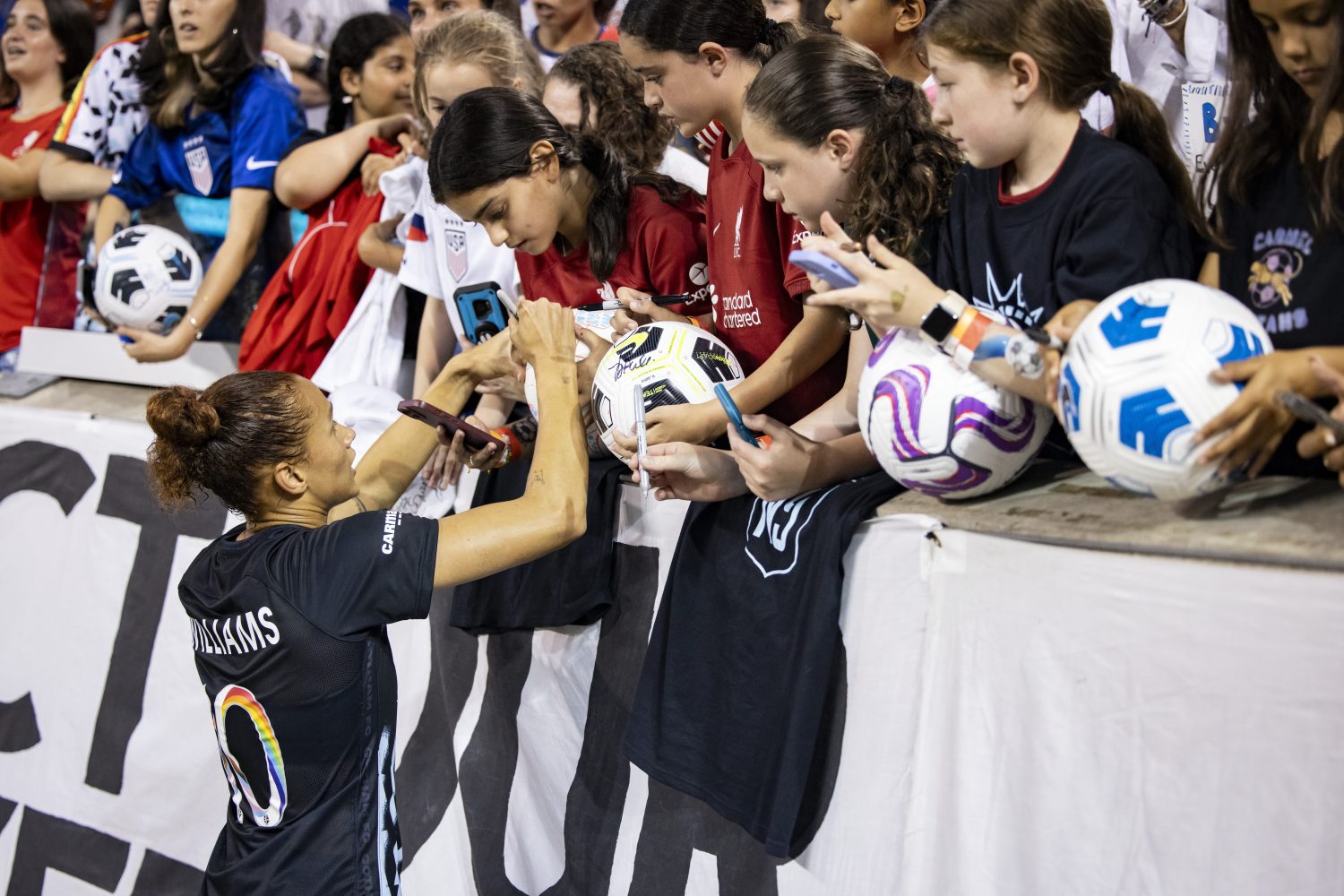
That doesn’t seem to matter. The USL Super League already has a pact with a media rights brokerage firm, Sportfive, that will negotiate TV deals in the U.S. and, potentially, overseas as well. Perhaps the USL Super League stakeholders have considered that discussions about the pitfalls of expansion have been around MLB, as one example, for decades and they haven’t stopped that league or its franchises from growing in terms of value in the slightest. Even while MLB faces challenges keeping teams in cities where they’ve resided for decades and built up loyal fanbases, it’s a near certainty that the league will expand further in the near future. The NFL, already by far the most profitable pro sports league in the U.S., is looking to expand in Europe, possibly with enough teams to fill an entire new division.
So for now, the growth of sports isn’t slowing down, and it shows few if any immediate signs that it’s about to “fall off a cliff,” as Mike Lewis fears may one day happen. (And admittedly this piece barely scratches the surface of the sports investment developments.) Let us not forget, though: On the back of the dot-com bubble, 1999 was a record year for the stock market, one that had many predicting “a booming global economy in the new year,” as the Los Angeles Times wrote on January 1, 2000 — what wound up being a few months before the bubble burst. And 2022 was declared by The Ringer as the year the streaming bubble burst. The rise in digital TV platforms has been a key contributor to the recent wave of sports investment because they’ve simply given the competitions new places to turn up in front of eyes.
Hopefully for Flint Lane, a resident of Princeton, New Jersey, who grew up on that same long island where the Drone Racing League was conjured up, a sports recession doesn’t manifest anytime soon. His venture? Major League Table Tennis — yep, ping pong, which also has its own absurdist comedy film dedicated to it. Lane, who says over the phone that he’s been “passionate” about table tennis for years, wants his MLTT to begin competitions by September, if not sooner.
“There’s [table tennis] pro leagues in like a dozen other countries, and seemingly every other sport has a league in this country,” says Lane, who made millions after founding a software company called Billtrust. “I put on ESPN the other day, there is three-on-three basketball, which is a bunch of, like, older NBA players; there’s a tag league, where they run around an arena and tag.” Meanwhile, he continues, “Table tennis is the most popular racquet sport on the planet; it’s an Olympic sport. It’s crazy to me that nobody’s tried to pull this off.”
MLTT has launched a worldwide talent recruitment effort, Lane says. He expects that, over time, as revenue increases, for him and his other well-endowed partners, MLTT will continually attract better players. In its first season, the league will be home to eight teams, each with eight players, representing “second-tier cities,” as Lane describes them, “that are not used to having live sports they can attend.” Up for grabs? $250,000 in prize money, an amount that will surely grow with a juicy media rights package sold to a content publisher of some prestige.
“The way I look at it is if some of these super fringy sports can get TV deals, I would be shocked if we can’t figure it out,” he says during our phone call.
On July 27, a few days afterward, he forwarded me an MLTT press release. It said that on August 4, Lane’s new table tennis league would be featured on ESPN2 — rebranded as “The Ocho.”
The Charge will help you move better, think clearer and stay in the game longer. Subscribe to our wellness newsletter today.
